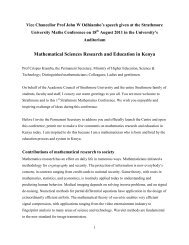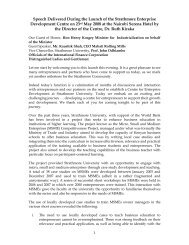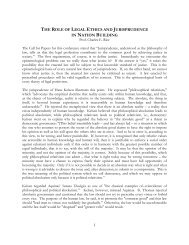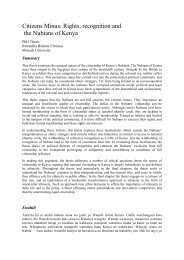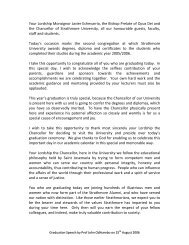Lucy-Gikonyo-paper Nataka-Chakula.pdf - Strathmore University
Lucy-Gikonyo-paper Nataka-Chakula.pdf - Strathmore University
Lucy-Gikonyo-paper Nataka-Chakula.pdf - Strathmore University
- No tags were found...
You also want an ePaper? Increase the reach of your titles
YUMPU automatically turns print PDFs into web optimized ePapers that Google loves.
expected to grow by 10 per cent by 2010 (Data Monitor, 2006). Stuppy (2009) noted<br />
that top reasons today's consumers choose foods are because of taste, price,<br />
healthfulness, and convenience in that order. Therefore, food manufacturers and<br />
restaurants will need to be attentive to these as they compete for consumer dollars.<br />
Katago (2009) asserts that the “eating out” culture is yet to pick in Kenya, despite a<br />
rapid expansion in urban centers and a growing middle class. This is contrary to the<br />
trend in the developed world where individuals and families take meals in restaurants,<br />
and they even make an occasion out of it.<br />
Mutisya, Sagwe and Kazungu (2010) sought to explore the emerging casual dining<br />
trends in the restaurant industry in Kenya. The findings of the study show that dining<br />
out is taking a more casual approach, and that having a food selection that reflects the<br />
ethnicity of the target market is an important aspect.<br />
Critical Success Factors Theory<br />
The identification of “success factors” was first proposed by Daniel, (1961) in an article<br />
on Management Information Crisis. It was later refined by Rockart (1979:85) who uses<br />
the term ‘Critical Success Factors’ to mean: “The limited number of areas in which<br />
results, if they are satisfactory, will ensure successful competitive performance in an<br />
organization”. In this definition Rockart (1979) emphasizes that these areas of activity<br />
are key and must “go right”, therefore they should be carefully managed by the company<br />
to ensure success. Other definitions exist, Leidecker and Bruno (1984:24) saw CSFs as<br />
“those characteristics, conditions or variables that when properly managed, can have a<br />
significant impact on the success of a firm competing in a particular industry”.<br />
Rockart (1979) identifies sources of CSFs as industry based, from environmental<br />
situations, geographical locations, temporal factors or strategic situations. This approach<br />
of CSFs focuses on information needs for purposes of management control and seeks to<br />
identify data which can be used to monitor and improve existing areas of business<br />
(Amberg, et al, 2005). In some research, this emphasis of deriving CSF from<br />
4





